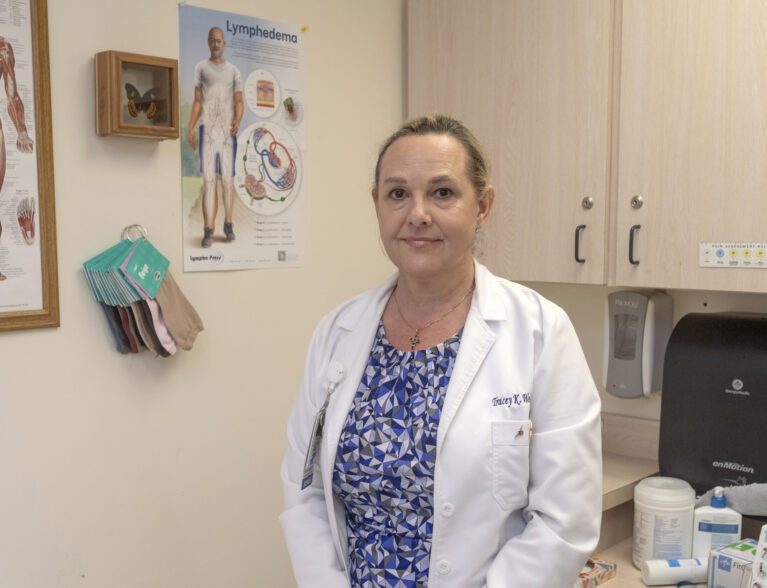
Up to 250 million people worldwide have lymphedema, including an estimated 10 million in the United States, according to the Lymphatic Education & Research Network. That is more than all of those who have HIV, Parkinson’s disease, multiple sclerosis, muscular dystrophy and ALS combined.
Cleveland Clinic defines lymphedema as swelling that happens when something harms your lymphatic system. Lymphedema often affects the arms and legs but may also affect other areas of the body and there is no cure for the condition.
Tracy Weber, DPT, CLT, a certified lymphedema therapist at Steward Rehabilitation Services, says that although there isn’t a cure for lymphedema, a good therapist can help patients learn how to self-manage their condition.
“Primary lymphedema is rare and may appear at any time, although it stems from a genetic mutation present at birth,” Weber explains. “Secondary lymphedema is far more common and results from damage to the lymph nodes or lymphatic system from such things as cancer treatment, infection or surgery.”
The lymphatic system is a network of vessels, nodes, and ducts that collect and circulate excess fluid in the body. It is part of the immune system, maintains fluid balance and plays a role in absorbing fats and fat-soluble nutrients.
There are 500-600 lymph nodes throughout the body that swell in response to infection due to a buildup of lymph fluid, bacteria, or other organisms and immune system cells.
Medical News Today writes that the recommended treatment for moderate to severe lymphedema is decongestive lymphedema therapy (DLT), which combines manual lymphatic drainage, compression therapy, exercise, and skin care to reduce swelling and improve symptoms.
For those who are overweight or obese, losing weight can help alleviate lymphedema symptoms by reducing the added stress on the lymphatic system. Maintaining a moderate body weight can generally help reduce swelling and improve lymphatic function.
Weber says that lymphedema comes on gradually. “Once you start to see swelling, you should wear knee-high compression stockings. Get a recommendation from your primary care doctor for a lymphedema massage therapist or vascular surgeon.”
Jane Coyne, a medical message therapist, offers a variety of holistic health services at Sandalwood Massage & Bodywork by Jane, including targeted medical massage therapy to treat lymphedema. She says that initially lots of people ignore swelling somewhere in their bodies. “They think it’s a sign of aging,” she says.
When a patient first comes to Coyne for a medical massage, she suggests they make an appointment with a vascular surgeon since there’s usually a vascular issue involved with lymphedema, often a blockage.
Mayo Clinic cites the most commons causes of lymphedema as:
- Cancer. If cancer cells block lymph vessels, lymphedema may result. For instance, a tumor growing near a lymph node or lymph vessel could enlarge enough to block the flow of the lymph fluid.
- Radiation treatment for cancer. Radiation can cause scarring and inflammation of lymph nodes or lymph vessels.
- Surgery. In cancer surgery, lymph nodes are often removed to see if the disease has spread. (However, this doesn’t always result in lymphedema.)
- Parasites. In developing countries in the tropics, the most common cause of lymphedema is infection with threadlike worms that clog the lymph nodes.
Coyne says that both pre- and post-surgical lymphatic massage are important. “If you have a massage several days prior to surgery, it helps rid your body of toxins and you will heal more quickly.”
Johns Hopkins University outlines the four stages of lymphedema and how they should be treated:
- Stage 1: Abnormal flow in the lymphatic system. No signs or symptoms.
- Stage 2: Accumulation of fluid with swelling. Swelling resolves with elevation. Pressing on the area may leave a dent.
- Stage 3: Permanent swelling that does not resolve with elevation. Pressing on the area no longer leaves a dent. Changes in the skin with scarring and thickening.
- Stage 4: Elephantiasis (enlarged, deformed limb), skin thickening with “wart-like” growth and extensive scarring.
Treatment for lymphedema depends on the severity and extent of the condition. Prevention and controlling lymphedema play an important role since there is no cure.
Decongestive treatment is commonly recommended for the first two stages of lymphedema.
Treatment options may include exercise, wearing a customized compression sleeve or elastic bandage, eating a well-balanced diet, and controlling body weight and preventing infection.
Once lymphedema has progressed to stages 3 or 4, surgical intervention may be recommended. Options include physiological and excisional procedures. Both procedures aim to restore lymphatic flow.
Physiological procedures involve rewiring the lymphatic system within the limb, while excisional procedures focus on removing diseased tissue. Your medical professional will discuss which procedure is most appropriate for you if it becomes necessary.
Both Weber and Coyne stress the connection between chronic venous insufficiency (CVI) and lymphedema and suggest those who suffer from the former be alert to possible progression to the latter. It is estimated that about 30 percent of the population has some form of venous disease and for many of those it’s CVI.
Chronic venous insufficiency occurs when veins in your legs are damaged. As a result, they can’t manage blood flow as well as they should, and it’s harder for blood in your legs to return to your heart. CVI causes blood to pool in your leg veins, leading to high pressure in those veins. A common complication of CVI is secondary lymphedema.
Tracey Weber received a Doctor of Physical Therapy degree from the University of St. Augustine in 2013. She is a Certified Lymphedema Therapist and Certified. She works at Steward Rehabilitation Services, 2400 N. Courtenay Parkway, Merritt Island. Call 321-637-2878 or visit rockledgeregional.org/services-directory/rehabilitation-services for more information.
Jane Coyne is the owner of Sandalwood Massage & Bodywork by Jane. She is a board-certified massage therapist and a certified medical massage practitioner with certification of Manual Lymphatic Drainage (MLD-C). She works at two locations: 333 17th St. Suite E, Vero Beach, and 2251 Town Center Ave, Suite 101, Unit 20, Viera. Call 772-779-1137 or visit sandalwood.glossgenius.com.



